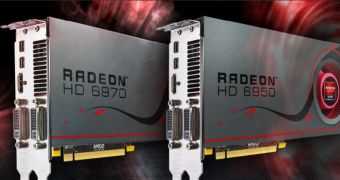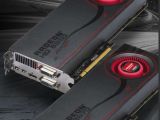Although the leaks that occurred over the past few weeks and months have provided us with plenty of information regarding what we could (and should) expect from AMD's Cayman-based graphics cards, the day when AMD officially releases its next-gen Radeon HD 6900 series GPUs has finally arrived.
So, today, the company took the wrapps off its first two HD 6900 models, the flagship Radeon HD 6970 and the Radeon HD 6950, which will soon be pitted against their rivals from NVIDIA in an epic struggle for the consumers' attention (and cash).
The Radeon HD 6970 delivers 2.7 TFLOPs (IEEE754-SP)/675 GFLOPs (IEEE754-DP) of compute power, featuring a Core Clock Speed of 880MHz, 24 SIMD / 1536 ALU Stream Processors, 96 texture units, 32 ROPs and 128 Z-Stencils, 2GB GDDR5 memory on a 256 bit and 5.5 Gbps bandwidth, while the board power is rated below 300W.
The AMD Radeon HD 6950, on the other hand, delivers 2.25 TFLOPs (IEEE754-SP)/563 GFLOPs (IEEE754-DP) of computer power with the help of its Core clocked at 800MHz, as well as its 22 SIMD / 1408 ALU stream processors.
The second 6900 series Radeon also features 88 texture units, the same ROPs / Z-Stencil figures as the its more powerful sibling, as well as the same amoung of memory (although the bandwidth is slightly smaller, just 5 Gbps), but a lower power consumption (TDP under 225W).
After checking out the tech specs, we'll also have to mention that, theoretically, the HD 6970 is 15 percent faster than the 580 and the 6950 is 20 percent faster than the 470, but no comparative data involving the 500 series from NVIDIA has been provided.
Both cards sport pretty much the same connectivity options (2xDVI + 2x mDP + HDMI), while also coming equipped with some of AMD's trademark technologies, such as AMD Eyefinity technology, AMD CrossFireX technology and Enhanced Quality Anti-Aliasing.
Similar to the GTX 500 series from NVIDIA, the Radeon HD 6900 series cards come equipped with a TDP-limiting technology, called AMD PowerTune, that clamps GPU TDP to a pre-determined level with the help of an integrated power control processor that monitors power draw every clock cycle and dynamically adjusts clocks for various blocks to enforce TDP.
However, unlike NVIDIA's solution, PowerTune provides direct control over GPU power draw (as opposed to indirect via clock/voltage tweaks), and is user controllable via AMD Overdrive Utility.
Another important technical detail worth mentioning as far as the Radeon HD 6900 series is concerned is the use of VLIW4 thread processors, that replace the previous VLIW5 design, providing a better level of utilizaton, with up to 10 percent improvement in performance/square mm, especially since all of the stream units now sport equal capabilities.
All in all, we're talking about some pretty impressive graphics units here, and all it remains to be seen right now is just where exactly on the market they'll position themselves, not only in terms of real-life performance, but also as far as the overall pricing is concerned (the 6950 is priced at around 299 US dollars, while the 6970 sells for around 370 US dollars, just a tad more expensive than the GTX 570).

 14 DAY TRIAL //
14 DAY TRIAL // 
